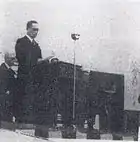United Church of Christ in Japan
The United Church of Christ in Japan (UCCJ; Japanese: 日本基督教団 Nihon Kirisuto Kyōdan, or Kyōdan for short) is the largest Protestant denomination in Japan. It is a union of thirty-three diverse Protestant denominations forcibly merged by the Japanese wartime government on June 24, 1941. The UCCJ, which is a Japanese Independent Church, is a member of the World Council of Churches (WCC).
| The United Church of Christ in Japan 日本基督教団 Nihon Kirisuto Kyōdan | |
|---|---|
| Abbreviation | UCCJ |
| Classification | Japanese Independent Church |
| Associations | World Council of Churches Christian Conference of Asia National Council of Churches in Japan |
| Region | Japan Eleven other countries |
| Origin | 24 June 1941 Fujimicho Church |
| Merger of | Thirty-three denominations |
| Separations | Anglican Church in Japan Japan Assemblies of God Japan Baptist Convention Japan Holiness Church Japan Lutheran Church Reformed Church in Japan The Salvation Army[1] Nihon Kirisuto Kyokai (Church of Christ in Japan) Numerous evangelical churches |
| Congregations | 1,725 |
| Members | 160,000 |
| Ministers | 2,189 |
| Official website | |
Currently, the church has some about 200,000 members and 1,725 congregations served by 2,189 pastors.[2]
History
Second World War

Upon promulgation of the Religious Organizations Law that forced the merger of all the Protestant churches in Japan to unite, a declaration of church unity was made at a mass meeting of Christians from all parts of Japan on 17 October 1940. The Kyōdan was established at a Founding General Assembly held at the Fujimicho Church (founded by Uemura Masahisa) on 24–25 June 1941.[4]
After 1945
With the establishment of religious freedom by the Allied Occupation Forces in 1946, many groups left the Kyōdan to reestablish their prewar denominational identities. The most significant departures were the Anglican Church in Japan, the Japan Lutheran Church, Japan Baptist Convention, Japan Holiness Church, Japan Assemblies of God, Reformed Church in Japan (the Reformed Church in Japan did not exist as a denomination in the prewar era [5]) plus numerous smaller evangelical churches.
After the 1970s
The controversy had both theological and non-theological roots, some tending back into an earlier period. The union's wartime origin and the church's self-acknowledged complicity in the war were called into question.[6] While the 1954 Confession of Faith,[7] a doctrinal statement, clarified the postwar church's identity (there are debates about this[8]), many cite the 1967 Confession of Responsibility During World War II as recovering the church's integrity, by openly dealing with the church's wartime role.
Twenty-six UCCJ missionaries now serve in eleven overseas lands in a variety of ministries, a heritage begun when the first postwar missionary was sent to Brazil in 1957.[9]
United Church of Christ in Japan permits openly gay and lesbian pastors to act as ministers.[10]
Seminaries and theological colleges[11]
- Tokyo Union Theological Seminary
- Doshisha University
- Kwansei Gakuin University
- Tohoku Gakuin University
- Seinan Gakuin University
- Seiwa College
- Tokyo Bible Seminary
- Japan Biblical Theological Seminary
- Rural Mission Human Right Seminary 農村伝道神学校
Notable members
- Kenji Goto (d. 31 January 2015) – journalist beheaded by the Islamic State of Iraq and the Levant
References
- "United Church of Christ in Japan". Oikoumene. Retrieved 4 February 2015.
- http://www.oikoumene.org/en/member-churches/united-church-of-christ-in-japan http://www.oikoumene.org/en/member-churches/united-church-of-christ-in-japan
- ""THE TWO EMPIRES IN JAPAN"" by John M.L. Young
- "A BRIEF HISTORY OF THE KYODAN". The United Church of Christ in Japan - English. The United Church of Christ in Japan. Retrieved 4 February 2015.
- http://rcj-net.org/History_of_Reformed_Church_in_Japan.pdf
- The UCCJ was formally established in June 1941.
- "信仰告白What We Believe | 日本基督教団公式サイト".
- e.g.日本基督教団宣教研究所教団史編纂室(編)『日本基督教団史資料集 第3巻』(日本基督教団出版局、1998)173頁
- cf.https://uccj.org/knl/43575.html
- Bunkasha, Hyogen. "A Pastor's Passion: Building A Church Where All People Pray Together" (PDF). sccmission.net. SOGI. Retrieved November 30, 2015.
- "神学校・キリスト教教育主事School of Theology and Christian Education | 日本基督教団公式サイト".